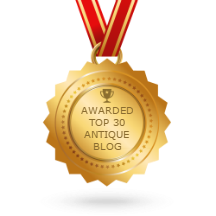
I don't sell a lot of antique beds. Why is that?
Maybe I just stink at sales. But more likely, it's because:
1. Many antique beds were heavily upholstered or were built right into (and were part of) room paneling (called "boiserie" and pronounced "bwah zer REE"), and as a result, not that many genuine antique beds survive to this day; and
2. 18th c. and 19th c. antique beds were not built to our modern standard sizes (e.g., Eastern King, Cal King, Queen, etc.)--and very few people want to do custom matresses and linens.
And even fewer people are foolish enough to "chop" a perfectly good antique bed to conform to modern dimensions. That explains why our custom workshop is often tasked with creating antique-inspired bed reproductions. Here's a lacquered chinoiserie king bed we created:
Nonetheless, I get a lot of questions and requests for antique beds so it's probably worthwhile to cover them here.
You can best understand antique beds if you understand antique bed terminology:
Tester or baldacchino: a full canopy that may or may not be supported by posts
Half Tester: a half tester is a partial canopy above the headboard


Lit (pronounced "lee"): the word for bed in French
Lit à Colonnes (pronounced "ah coh LUN"): a four poster bed with a full canopy. Here's an example of an English Jacobean lit à colonnes

Lit à Couronne ("ah koo RUN"); a lit a bateau (boat bed) with a crown shaped canopy
Lit à la Duchesse ("ah la doo SHESS"): a bed introduced in the 17th c. with a low headboard
Lit à la Polonaise ("ah la puh low NEZ"): a bed where the head and feet are the same size
Lit à la Turque ("ah la TURK"): a bed placed horizontally against a wall

Lit d'Ange ("DAHNZH"): a bed with a tester but no posts (the tester floats like an "angel" over the bed)--the à la Turque bed above is also a lit d'Ange.
Lit de Anglais: ("dahn GLAY"): same as a lit à la Turque (see above)
Lit de Parade ("duh puh RAHD"): a bed with elaborate curtaining and canopy

Lit de Repos ("dur ruh POE"): a daybed
 Lit en Bateau ("ahn ba TOE"): a boat shaped bed
Lit en Bateau ("ahn ba TOE"): a boat shaped bed
Lit Jumeaux ("zhoo MOE")k: a twin bed










9 comments:
What an absolutely educational post. Thank you very much for explaining the many different styles of beds. Fascinating.
In the South, we hear "tester" pronounced "tea-stir", What's the verdict? tea-stir or test-ter?
Great blog.
Just had to add, I've gone back through your older post--and I can't stop laughing! You are just too funny! I adore it when I learn something while have fun. Thanks for the education and giggles!
Thanks for the nice comments! I'm glad you're enjoying my blog. Blush.
Also thanks for your question about the pronunciation of "tester". I would have to say that "tester" as in "test" is the more correct pronunciation, as opposed to "tees" ter. Regional pronunciations of esoteric antique terminology do differ, but I'd go with the most commonly pronounced version, in this case "TEST stir." Hope that helps!
OMG!!! I have just stumbled onto your blog and think I have died and gone to antique education HEAVEN!!! For 2 hours I have been glued to my computer screen reading post after post! (I know, I know, I need to get a life!) My husband thinks I have lost my mind! Maybe....but more closely, my HEART! What amazing stuff! My only complaint: You aren't blogging NEARLY often enough!!! Maybe because you DO have a life! But, whatever the case, I can't wait for your next "offering". I think you are brilliant!
Thanks Vickie!
I just had a friend call me and ask how much I paid you to write that! But then I reminded him how cheap I am and he realized you wrote it yourself.
I'll try and do more posts going forward but, alas, my main job is selling and restoring antiques as well as doing custom work for the trade. Luckily, I love doing that as well so it's all good.
Buzz
Antique beds are usually titled by the primary influence, time period or country of origin from which they are produced. Generally speaking, this means that the bed will have a country adjective in front of it, such as Italian or Swiss. It might have the time period which could denote a country of origin, such as Victorian which might refer to the era or Victorian England.
We are a group of volunteers and starting a new initiative in a community. Your blog provided us valuable information to work on. You have done a marvelous job!
Antique Furniture Melbourne
What is the etymology of the word "tester?" Why is the background for two pronunciations of the word?
Hello! I found your post so informative. I absolutely love those different accents of antique beds. Awesome it is! :)
Post a Comment